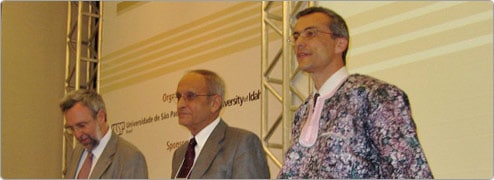10th IIBCC, São Paulo, Brazil, 2006

Moving frontiers – the first time in South America: November 15-18, 2006, the 10th IIBCC was held in São Paulo, Brazil under the management of Universidade de São Paulo in cooperation with University of Idaho. This was the first time the conference moved outside North America. The opportunity was made possible, due to the cooperation between Prof. Al Moslemi from the University of Idaho and his Brazilian colleagues; Professors Vahan Agopyan, Vanderley John and Holmer Savastano at the Universidade de São Paulo along with the organising team and Conference Committees.
The conference was visited by some 142 attendees, including invited participants. Attendees came in from all regions of the world; about 69% of them came from developing countries. South America participation was strongly influenced by a large number of Brazilian attendees.
Approximately 74% of the attendees represented the business community, corresponding to almost an equal share of producers and suppliers. The attendees from the academic business amounted to roughly a quarter of the total.
More than half (53.6%) of the 29 speakers from all over the world represented private companies. The industry supply chain was responsible for almost a third of the total technical content at the conference.
The 10th IIBCC, the first outside of North America, was a successful conference. It was a truly international conference with both speakers and attendees from all regions of the world. The traditional mix between industrial and academic areas was also maintained.
Conference proceedings in CD-R contained 27 full papers, and a special issue on inorganic-bonded fiber composites containing 12 peer-reviewed manuscripts was accepted for publication in the Construction and Building Materials Journal, Elsevier.
SESSIONS 1 – 4
Processing of high performance fiber reinforced cement-based composites.
Surendra Shah, Prof. (Northwestern University & ACBM, USA).
Asbestos-free technology with new high tenacity pp – polypropylene fibers in air-cured hatschek process.
Ikai, S. (Brasilit – Saint Gobain, Brazil).
Eucalyptus fibre for fibrecement composites.
Manoel Faez, Mr. (Votorantim Celulose e Papel, Brazil).
Optimal use of flocculants on the manufacture of fibre cement materials by the hatschek process.
Carlos Negro, Prof. (Department of Chemical Engineering, Universidad Complutense de Madrid, Spain)
Microsilica – characterization of an unique additive
Bernd Friede, Dr. (Elkem Materials, Norway)
Long-term durability of Kuralon (PVA fiber) in alkaline condition
Hideki Hoshiro, Dr. (Kuraray, Japan).
Comparisons of different synthetic fibers as the main reinforcement of air-cured fiber cement.
Holmer Savastano Jr. (University of São Paulo, Brazil)
The technical specification of matrix raw materials for hatschek technology based fibre-cement – a pragmatic approach
Luc Van der Heyden (REDCO N.V., Belgium)
Advantages of using fly ash as supplementary cementing material (scm) in fibre cement sheets.
Jagadesh, Sunku (Hyderabad Industries Limited, India)
Poly(borosiloxanes) as precursors of ceramic matrix in carbon fiber composites.
Luiz C. Pardini (Centro Téc. Aeroespacial / Inst. de Aeronáutica e Espaço – CTA / IAE, São José dos Campos – SP, Brasil)
A micromechanical model for fiber cement optimization and component tailoring.
Victor Li, Prof. (University of Michigan, USA)
Inorganic – bonded strandboards manufactured from white yam (dioscorea rotundata) strand.
Ajayi Babatunde (Federal University of Technology, Nigeria)
Syro oiling system hb 2000 – high performance mould oiling device.
Andrew Kupferschmid, Mr. (Syro, Switzertland)
Production of cement bonded particle board (cbpb) and wood strand cement board on one plant and major applications of both products.
Ing. Bert van Elten, Mr. (Eltomation, Netherlands)
Silicone water repellents for fiber-cement boards.
David B. Selley (Dow Corning Corporation, USA)
SESSIONS 5 – 8
Cracking in fibre cement products.
Stephen Akers, Dr. (Akers Consulting, Switzerland)
Durable phosphate-bonded natural fiber composite products
Matthew D. Aro; Patrik k. Donahue (University of Minnesota Duluth Natural Resources Research Institute, USA)
Performance of slash pine fibers in fiber cement products.
Stephen Akers, Dr. (Akers Consulting, Switzerland)
Effects of process parameters on porosity and crack risk in fiber-cement sheets
Hulya Kus (ITU Faculty of Architecture, Istanbul, Turkey)
Functionally graded materials concepts applied to asbestos-free fiber cement.
Vanderley Moacyr John, Prof. (University of São Paulo, Brazil)
The use of cement fibre composites in prolonged wet environments
Branko R Babic (OXFORD, UK)
Physical and mechanical properties of cement-gypsum board made from core-kenaf (hibiscus cannabinus l.) using autoclave curing technology
Rohny Setiawan Maail (Faculty of Agriculture, Pattimura University, Ambon, Maluku – Indonesia)
Development of non-asbestos fibre cement products in China
Lin Zhen (China Building Materials Academy, Beijing, China)
Performance of geopolymeric concrete reinforced with steel fibers
Susan, Bernal. (CENM, Universidad del Valle, Cali, Colombia.)
Accelerated carbonation on vegetable fibre reinforced cementitious roofing tiles.
Holmer Savastano, Dr. (University of São Paulo, Brazil.)
Production of wood wool cement board (wwcb) and wood strand cement board (eltoboard) on one combined production plant.
Gerry van Elten, Mr. (Eltomation, Netherlands)
Report about experiences with cement based corrugated sheets vacuum processing.
Silvio Delvasto, Prof. (Universidad del Valle, Colombia)
The Turkish Fibre-Cement Market from 1950’s to 2010
Emin Özgür (Atermit, Turkey)
Using silica fume and fly ash in production of non-asbestos fibre cement boards in Vietnam.
Pham The Dong (Nam Viet Joint Stock Company (NAVIFICO), Vietnam)
Sepiolite – a natural additive in air-cured Hatschek process.
José Garcia (Grupo Tolsa S. A., Spain.)
Vegetable residue and portland cement chemical compatibility by ultrasonic pulse velocity (upv).
Antônio L. Beraldo (Agricultural Engineering Faculty – Campinas University – Brazil)
